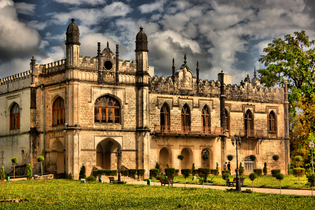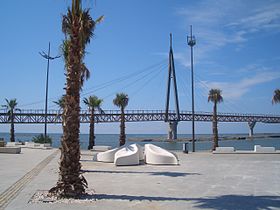Zugdidi Municipality
Zugdidi Municipality | |
|---|---|
 | |
|
UTC+4 (Georgian Standard Time) | |
| Website | http://zugdidi.mun.gov.ge/ge |
Zugdidi (Georgian: ზუგდიდის მუნიციპალიტეტი) is a Municipality of Georgia, in the region of Samegrelo-Zemo Svaneti. Zugdidi Municipality is located in the central part of western Georgia, and has an area of 692 square kilometres (267 sq mi). Its western border follows the Black Sea coast (Ganmukhuri, Anaklia), the administrative strip of Abkhazia (Gali district) in the northwest, Tsalenjikha Municipality in the north and northeast, and it borders Chkhorotsqu Municipality and Khobi Municipality to the south. Zugdidi is the administrative center of both Zugdidi Municipality and Samegrelo Zemo-Svaneti region. Between 2014 and 2017 the city of Zugdidi was separated from the municipality and was a so-called "self-governed" city (or kalaki), but this administrative and governance reform was deemed too inefficient and expensive.[5]
History
Ancient history

The territory of Zugdidi municipality, due to its economic-geographical location, seems to have been inhabited since ancient times. Archaeological sites confirm that coastal wetlands originated in the recent geological past. It can be seen that during the flourishing of the
During the Hellenistic period, an important trade route passed through the territory of modern Zugdidi municipality from Svaneti, on the river. Along the Enguri stream, in the direction of the Black Sea and from there, trade goods were transported to the Hellenic world (direct evidence of the development of this trade route must be the ancient necropolis of the village Riki, with the tombs of socially advanced members), which is confirmed by numismatic materials.
Zugdidi was an important city of ancient Georgia. Its etymology has been touched upon by many scholars, most of them suggest that Zugdidi // Zurgdidi // Zugdidi means a big hill in Megrelian. This was the name of the hill, which was later called Mantskhvarkarish Sukia (Hill of the Savior's Gate), after which the city built here took its name.[6]
Middle Ages up to early modern period
In written sources, Zugdidi is first mentioned by the narrator Beri Egnatashvili in 1572 in connection with the battle between Guria, the chief uncle of Guria, and George III, the chief of
In order to develop trade in Zugdidi, in 1636 Levan II Dadiani deported the Chkhareli Armenian and Jewish merchants who had been taken to the ransom of King George Imereti. "We built the city of Chkhari, settled in Zugdidi and settled in Rukhi." Gray was considered a part of Zugdidi, so the construction of Gray Fortress should have started at this time, the main purpose of which was to protect the city.
After the death of Levan II Dadiani (1657), the merchants who moved to Zugdidi were returned by King Alexander of Imereti to Chkhari, which significantly undermined the commercial profitability of Zugdidi. Moreover, the second half of the 17th century and the first quarter of the 18th century turned western Georgia into an arena of incessant civil feudal wars and Ottoman Empire raids, and Zugdidi itself was plundered many times.
In 1662, King
At the end of 1779, a joint army of
Geography and climate

According to the scheme of tectonic zones, the territory of Zugdidi Municipality is included in the Kolkheti subzone of the western subsidence zone of the Georgian Belt. According to the geomorphological features, it consists of three parts: 1. Accumulated Odisha lowland with flat surface (west and south-western part of the municipality up to the Black Sea), 2. Sloping Vake-Odisha plateau (east and north-east part of the municipality and flooded rivers and With a network of gorges), 3. Foothills and Urta mountain (on the border of Khobi municipality, height 469 m.), the northern slope of which is located in the territory of Zugdidi municipality.
The whole territory of Zugdidi Municipality is located in the humid subtropical climate of the sea, the plain and hilly strip are characterized by humid warm climate, snowless winters and hot summers. The proximity of the Black Sea has a great influence on the nature of the climate. High radiation balance leads to a high thermal regime. The average perennial air temperature near the land surface is over 14 degrees. The coldest month is January, the temperature is positive in the plain part and at this time it is 6-7 degrees on average, while in the upper part it is negative. The warmest months are July and August, with average monthly temperatures exceeding 22 degrees. The average absolute maximum air temperature is 34-36 degrees in the Black Sea coast, up to 38 degrees in the plains. The humid air masses rising from the sea cause high air humidity throughout the year. The partial pressure of water vapor is high in the Black Sea zone.
The territory of Zugdidi municipality is characterized by high cloudiness and heavy rainfall, the total cloudiness varies in the range of 60-70% during the year, and the cloudiness of the lower tier reaches 40-35%. The maximum of cloudiness in the annual course is observed in late winter and early spring, and the minimum in autumn. Annual precipitation varies between 1400 and 3000 mm. Uneven terrestrial heating, the presence of mountainous terrain and the proximity of the relatively warm Black Sea lead to the formation of winds of different directions and strengths. East winds prevail in the cold season of the year, while west (sea) winds prevail in the warm season. The number of foggy days varies from 10 to 50, with an average of 30-40 thunderstorm days.
Agro-climatic conditions are very favorable for the creation of multidisciplinary and highly profitable agricultural production, especially for the development of such fields as mesimindeoba, mechaieoba, production of subtropical crops (citrus, laurel, kiwi, feijoa, etc.), fruit and berry production. Many of the water bodies in the territory of Zugdidi Municipality are rivers, swamps and springs, which have played an important role in the economic and traffic relations of the local population since time immemorial. Of the great rivers, the Enguri and the Jumi are distinguished.
The territory of Zugdidi Municipality, as part of the Kolkheti Botanical Province, includes the lowland and foothill forest areas, while the Silnar-sandy vegetation area of the Black Sea coast belongs to the Euclidean part of the Mediterranean region. The main types of vegetation in the lowland and foothill forest areas are forests, water and swamp vegetation. Most of the forest vegetation is represented by secondary types - deciduous forests and shrubs, the main forest formations in the lowlands and foothills - alder, oak, brush-oak and brush-wood, hornbeam, chestnut and wood.[7]
Politics

Zugdidi Municipal Assembly (
Zugdidi was one of only seven municipalities where the ruling GD party failed to secure a majority in the city council.[8] The opposition party UNM became the largest party in Zugdidi, but was one seat short of an absolute majority, after a recount.[9] This led to protests later in the month, and a tense atmosphere around the second round of the mayoral election and afterwards.[10][11] After several attempts, the opposition parties UNM and For Georgia agreed to a chairman of the Sakrebulo, four months after the elections.[12] Georgian Dream boycotted the vote.
| Party | 2017[13] | 2021[14] | Current Municipal Assembly | |||||||||||||||||||||||||||||||||||||||||
|---|---|---|---|---|---|---|---|---|---|---|---|---|---|---|---|---|---|---|---|---|---|---|---|---|---|---|---|---|---|---|---|---|---|---|---|---|---|---|---|---|---|---|---|---|
| Georgian Dream | 43 | 18 | ||||||||||||||||||||||||||||||||||||||||||
| Ahali | 14[a] | |||||||||||||||||||||||||||||||||||||||||||
United National Movement
|
5 | 8 | ||||||||||||||||||||||||||||||||||||||||||
| For Georgia | 3 | |||||||||||||||||||||||||||||||||||||||||||
| People's Power | 2[b] | |||||||||||||||||||||||||||||||||||||||||||
European Georgia
|
2 | |||||||||||||||||||||||||||||||||||||||||||
| Total | 50 | 45 | ||||||||||||||||||||||||||||||||||||||||||
Subdivisions of Zugdidi

The municipality consists of 30 administrative communities (temi) with a total of 58 villages. There is one city, Zugdidi.[2]
Among the 58 villages in Zugdidi Municipality are: Alertkari, Kolkhida, Chitatskari, Narazeni, Tsatskhvi, Darcheli, Rukhi, Urta, Sintsa, Didi Nedzi, Jikhashkari, Qulishkari, Odishi, Kortskheli, Bashi, Didobera, Ergeta, Tkaia, Kakhati, Ganarjiis Mukhuri, Shamgona, Tsaishi, Abastumani, Chkhoria, Riqe, Zeda Etseri, Chkaduashi, Ingiri, Akhalkakhati, Anaklia, Oktomberi, Orulu, Onaria, Orsantia, Akhalsopheli, Koki, Khurcha.
The city of Zugdidi was separated in 2014 from the municipality and was a so-called "self-governed" city (or kalaki). This administrative and governance reform was deemed too inefficient and expensive and was thus revoked in 2017.[5] Since then, the city of Zugdidi has been part of the general municipality again.
Population
By the start of 2021 the population was determined at 99,542 people,[3] a decline of 6% compared to the 2014 census.[17] The city of Zugdidi lost 3% of its population in this period, and los its position of 6th largest city in Georgia to Poti. The population density of the municipality is 143.8 inhabitants per square kilometre (372/sq mi).
The population consists for 99.6% of
| Population Zugdidi Municipality | ||||||||||||||||||
|---|---|---|---|---|---|---|---|---|---|---|---|---|---|---|---|---|---|---|
| 1897 | 1922 | 1926 | 1939 | 1959 | 1970 | 1979 | 1989 | 2002[18] | 2014[17] | 2021 | ||||||||
| Zugdidi Municipality | - | - | - | 74,246 | ||||||||||||||
| Zugdidi city | 3,407 | |||||||||||||||||
| Data: Population statistics Georgia 1897 to present.[19][20][21] Note:[18] | ||||||||||||||||||
The historic
Historical sites
- Dadiani Palace
- Chakvinji fortress
- Tsaishi cathedral
- Kolkheti National Park
- Zugdidi Botanical Garden
- Rukhi Fortress
- Anaklia Fortress
- Church of St. George in Tkaia
Gallery
-
Dadiani Palace
-
Dadiani Summer Palace
-
Tkaia church
See also
Explanatory notes
References
- ^ a b "Interactive results 2021 municipal elections". Agenda.ge. Retrieved 2021-01-02.
- ^ a b c "Main Results of the 2014 Census (Publication)" (PDF). Census.ge, National Statistics Office of Georgia (Geostat) (in Georgian). 2016-04-28. pp. 233–234, 243–247. Retrieved 2022-01-19.
- ^ a b "Population and Demography - Population by cities and boroughs (daba), as of 1 January". National Statistics Office of Georgia, Geostat. 2021-01-01. Retrieved 2022-01-03.
- ^ "Ethnic composition of Georgia 2014". Pop-stat.mashke.org. Retrieved 2021-06-19.
- ^ a b "Civil.Ge | Parliament Reduces Number of Self-Governing Cities". old.civil.ge.
- ^ a b ზუგდიდის მუნიციპალიტეტის ისტორია
- ^ მდებარეობა, განლაგება, მუნიციპალური ცენტრი
- ^ "GD Falls Short of Securing Majorities in 7 Sakrebulos". Civil.ge. 2021-11-01. Retrieved 2022-01-20.
- ^ "UNM Loses Majority in Zugdidi Sakrebulo". Civil Georgia. 2021-10-08. Retrieved 2021-01-30.
- ^ "Elections: Five Detained in Series of Brawls in Zugdidi". Civil Georgia. 2021-10-30. Retrieved 2021-01-30.
- ^ "Clashes, Detentions as Outgoing Councils Approve Batumi, Zugdidi Budgets". Civil Georgia. 2021-11-26. Retrieved 2021-01-30.
- ^ "Opposition Elects Chair in Hung Zugdidi Sakrebulo". Civil.ge. 2022-02-14. Retrieved 2022-02-14.
- ^ "Protocol elected municipal council members and mayors 2017" (PDF) (in Georgian). CESKO Central Election Commission. pp. 86–89. Retrieved 2021-01-06.
- ^ "Protocol elected municipal council members and mayors 2021" (PDF) (in Georgian). CESKO Central Election Commission. pp. 106–108. Retrieved 2021-01-06.
- ^ "ზუგდიდის საკრებულოში, ფრაქცია „ენმ" სახელი შეიცვალა - მისი სახელწოდებაა „ახალი"". interpressnews (in Georgian). 2024-04-04. Retrieved 2024-06-14.
- ^ "ზუგდიდის საკრებულოს 2 წევრი "ხალხის ძალას" შეუერთდა". radioatinati.ge (in Georgian). 2022-10-25. Archived from the original on 2023-02-27. Retrieved 2023-02-17.
- ^ a b Combined figures of the 2014-2017 city municipality (kalaki) Zugdidi and the municipality of Zugdidi.[2]
- ^ a b The 2014 census found an inexplicable gap with the data from the national statistical office Geostat. UN-assisted research has found the 2002 census was inflated by about 8-9 percent. See,[22] "1. Introduction", Page 1.
- ^ "Population divisions of Georgia". Population Statistics Eastern Europe and former USSR. Retrieved 2022-01-18.
- ^ "Population cities & towns of Georgia". Population Statistics Eastern Europe and former USSR. Retrieved 2022-01-18.
- ^ "Zugdidi district 1939". Ethno Kavkaz (in Russian). Retrieved 2022-01-30.
- ^ "Population Dynamics in Georgia - An Overview Based on the 2014 General Population Census Data" (PDF). National Statistics Office of Georgia, Geostat. 2017-11-29. Retrieved 2022-01-01.





